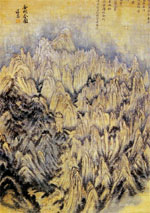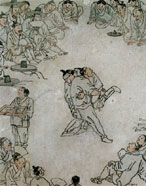![The figures on the walls of Muyongchong [the Tomb of the Dancers] from the Goguryeo Kingdom (37 B.C. - A.D. 668)](http://www.korea.net/cheditor40_asp/cheditor/attach/20085291528392254.jpg)
The figures on the walls of Muyongchong [the Tomb of the Dancers] from the Goguryeo Kingdom (37 B.C. - A.D. 668)
Although Korean painters showed a certain level of accumulated skills from the time of the Three Kingdoms, most paintings have been lost because they were drawn on paper. As a result, it is only possible to appreciate a limited number of paintings from this age such as the tomb murals.
In addition to the Goguryeo mural paintings, the landscape tiles of Baekje and the Painting of the Flying Horse of Silla combine to attest to the characteristics and quality of paintings during the Three Kingdoms. These works display energetic and bold lines and well-organized composition, distinctive features of this age.

Geumgangsan-do: Panoramic View of Geumgang Mountain by Joseon Dynasty artist Jeong Seon (1676~1759)
Only a handful of paintings of Unified Silla remain. Still, the painted illustrations of the teachings of the Avatamsaka Sutra (the Flower Garland Sutra) bears witness to the refinement of the paintings of this age. Exquisite and lively lines characterize these illustrations.
Both decorative and Buddhist paintings reached a peak during the Goryeo Dynasty. During this age, a great variety of paintings were produced.
The works from this period that have survived are mainly Buddhist paintings of the 13-14th century. The main features of these works include elegant postures, delicate and exquisite folds of the clothing and refined hues, indicative of the thriving Buddhism of this epoch.
The greatest advancement in Korean painting took place during the Joseon Dynasty. Trained professional painters and literati artists played a leading role in the development of painting. In particular, economic growth, political stability and ideological development in the 18th century served as catalysts for the predominance of uniquely Korean painting styles. This trend can be seen in landscape paintings of actual Korean scenes and genre paintings with secular themes.
![[Magpie and Tiger] a popular theme in folk painting](http://www.korea.net/cheditor40_asp/cheditor/attach/200852915582375564.jpg)
[Magpie and Tiger] a popular theme in folk painting
Jeong Seon (1676-1758) and Kim Hong-do (1745-1816) are regarded as two leading painters during this period. Based on Southern School paintings of China, Jeong Seon filled his canvas with picturesque scenery of the mountains of Korea, creating a distinctive Korean style. He had the greatest influence of any Korean artist on the development of literati tastes of his time, and this has continued down to the present. One of his masterpieces is “Panoramic View of Geumgang Mountains.”
In the meantime, the paintings of Kim Hong-do are greatly valued in that he captured the mundane lives of farmers, artisans and merchants. His precise but humorous depictions stand out.
In the late years of the Joseon Dynasty, the styles of painting further expanded. Untrained painters emerged as active producers of folk paintings to meet the demands of ordinary people. These folk paintings featured unconstrained use of vivid colors and boldly simplified and stylized designs.

SSireum, a Korean wresling painted by Joseon Dynasty artist Kim Hong-do (1745-c.1806)
Following Japan's forcible annexation of Korea in 1910, the traditional styles of painting were gradually overshadowed by Western oil painting styles that were introduced during that period and later became prevalent. After Korea's liberation from Japan's rule in 1945, traditional Korean painting styles were revived by a number of outstanding artists.
At the same time, many Korean artists educated in Europe and the United States helped their home country keep up with the contemporary trends of the outside world.
In the 1950s, a government-run institution, the National Exhibition played a leading role in the advancement of Korean art. The National Exhibition had a rather formal and academic atmosphere and tended to choose works that were realistic.
Young artists pursuing creativity in their works, therefore, sought an art in tune with the new age. From the late 1960s, modern Korean painting began to change its directions to geometrical abstraction. Other artists took a deep interest in subject matters that conveyed the innate unity between man and nature.
![[U.S. Map] by renowned video-artist Paik Nam-june (1932-2006) on display in the Smithsonian, Washington, D.C.](http://www.korea.net/cheditor40_asp/cheditor/attach/20085291040421998.jpg)
[U.S. Map] by renowned video-artist Paik Nam-june (1932-2006) on display in the Smithsonian, Washington, D.C.
Korean paintings of the 1980s were largely a reaction to the modernism of the 1970s. During this period, artists strongly felt that art should convey a message dealing with current social issues. Since then, there has been an interest in the issues of modernism and post-modernism.
In 1995, the International Gwangju Biennale was held. The event provided an opportunity for modern Korean artists to get together with leading figures from the international art world. Paik Nam-june's video art was one of the most prominent exhibitions.
In Korea today, both traditional and Western-style painting are taught and pursued, producing one of the most versatile communities of fine arts in the world. Many Korean painters are active in New York, Paris and other centers of contemporary art.